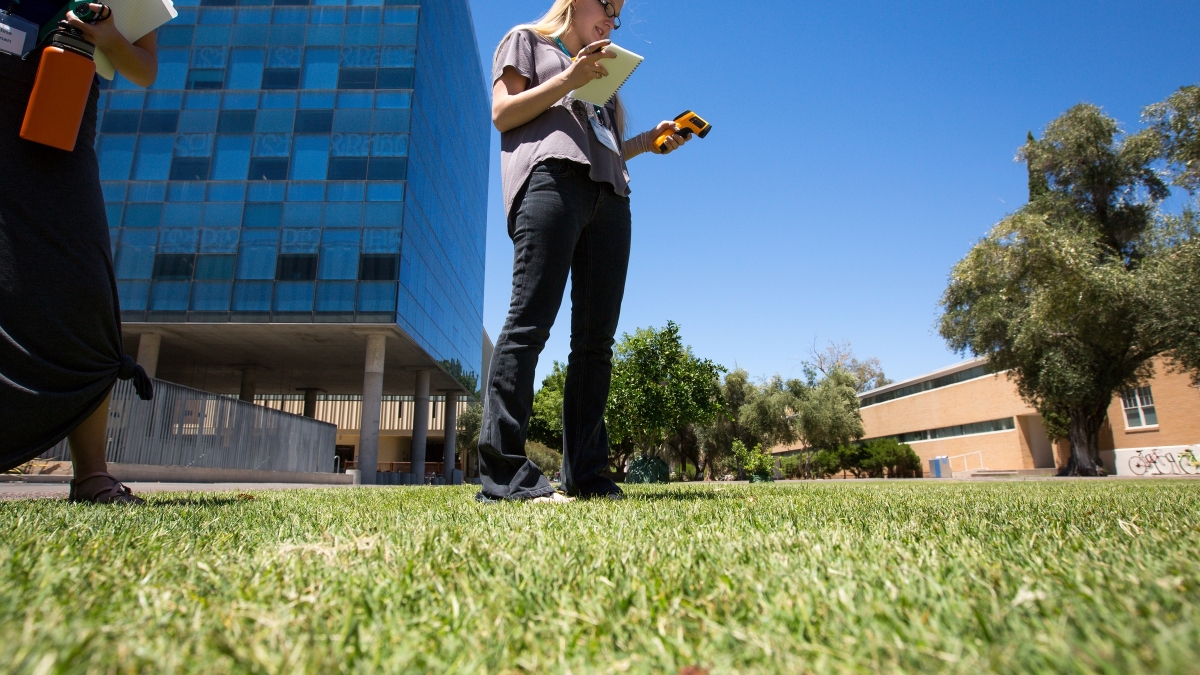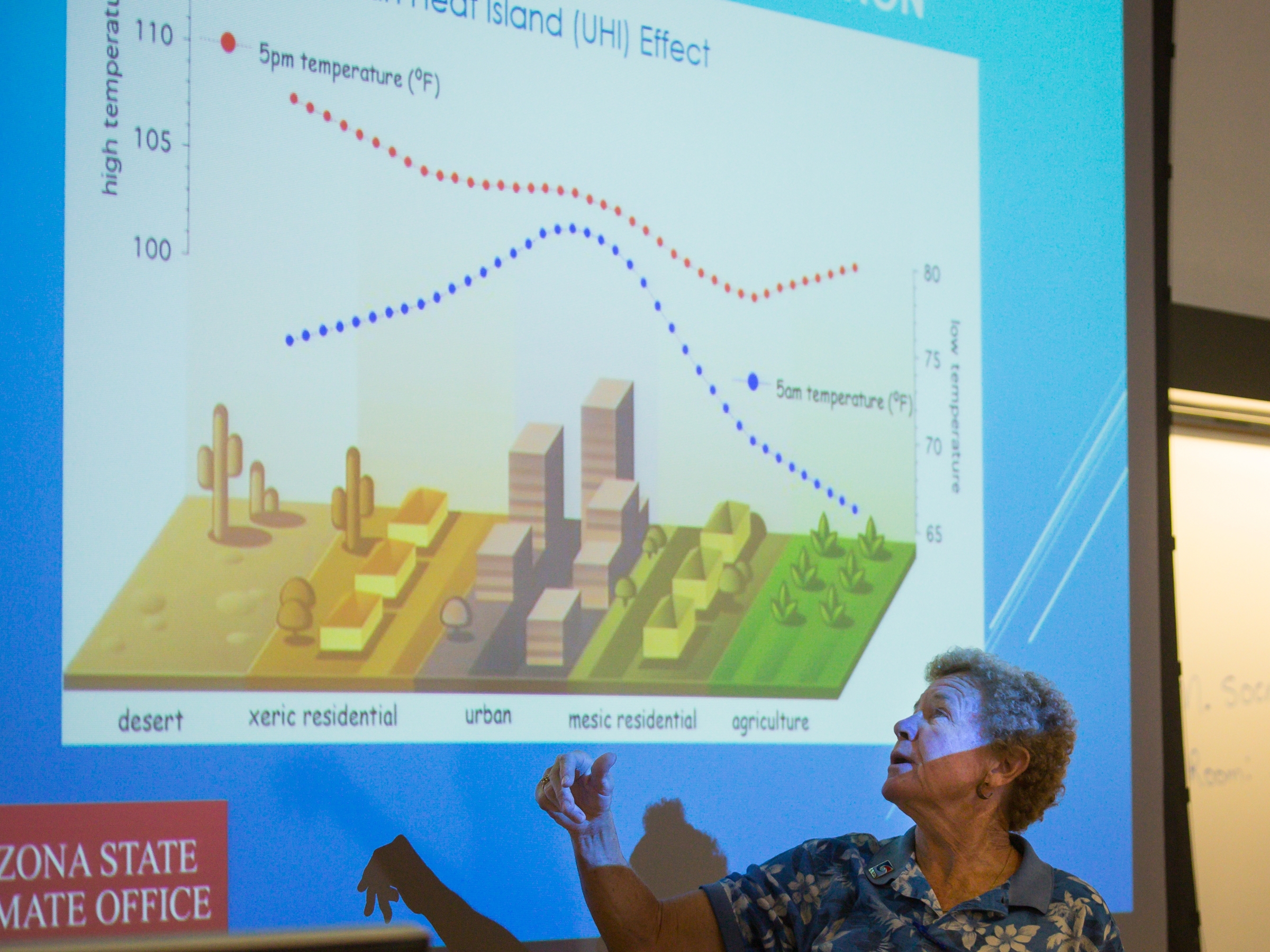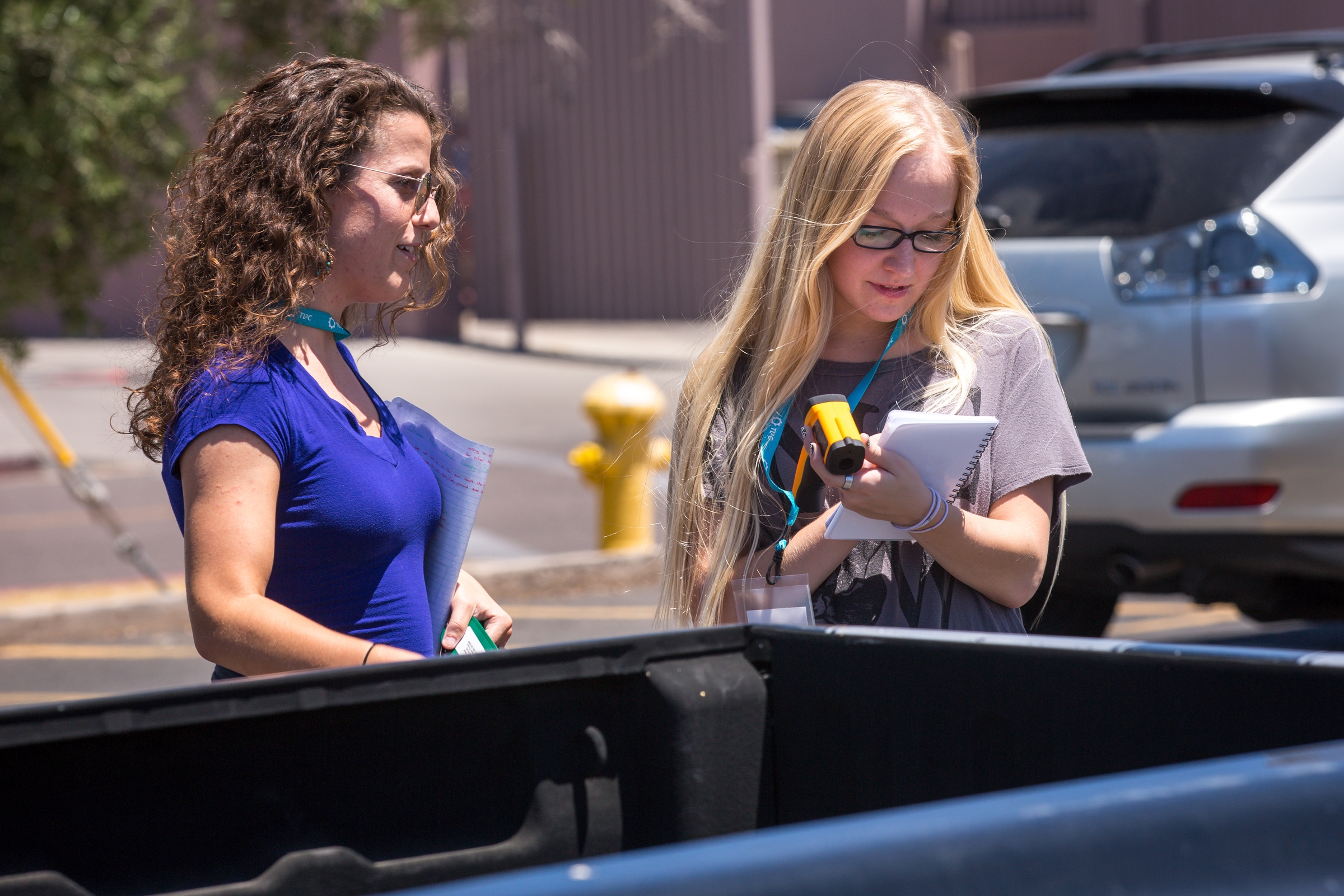Kids might not love to study rocks, but they gravitate to gadgets and that’s one way to engage them in learning science.
A group of K-12 teachers spent half an hour during a hot afternoon this week pointing infrared thermometers at parking lots, patches of grass, benches, stop signs, cars and various other objects.
“So the rubber was hotter than the metal,” noted Madeline Goodman as she and Genevieve Conn (pictured at top) logged the temperatures of bicycles in a rack.
Goodman and Conn were among 18 educators who are spending part of their summer break at the Science, Technology, Engineering, Math and Social Studies Institute on the Tempe campus of Arizona State University.
The institute, like a science summer camp for teachers, is sponsored by the Arizona Geographic Alliance, which is housed at ASU.
The sessions mix geography with the STEM disciplines and include topics such as “Let’s Plan a Road Trip,” “Using Forensic Science to Investigate the Disappearance of Ancient Rome’s Ninth Legion” and “Is It Good or Is It Bad: Genetically Modified Foods.” The teachers hear speakers, create projects and make site visits.
The session with the thermometers was led by Nancy Selover, the state’s climatologist and a research professor in the School of Geographical Sciences and Urban Planning.
Nancy Selover talks about urban heat islands to the teachers attending the Science, Technology, Engineering, Math and Social Studies Institute at ASU. Photo by Charlie Leight/ASU Now
She discussed urban heat islands, how different objects hold heat and how to measure it.
“These are fun things, and kids love them,” she said, holding up the thermometers, which actually measure the thermal radiation of objects.
“I say to a kid, ‘Should you wear a black T-shirt?’ And he says, ‘Black is cool’ and I say, ‘Well, take the temperature of it and see how cool it is.’
“They can go to a parking lot and take the temperatures of different-colored cars. Then they start thinking about how all those things matter.”
Goodman, a kindergarten teacher at Capitol Elementary School in the Phoenix Elementary School District, said her students would love a chance to study outside.
“I would do this in small-group setting and have them sort out hot and not and talk about what things were hotter and where were they,” she said.
“Kindergarten is really about teaching children how to read, letter sounds and letter sense, so we don’t have a lot of time for social studies and science,” Goodman said. “I’ve gotten so many ideas that I can incorporate into my practice.”
Gale Ekiss, the co-coordinator of the Arizona Geographic Alliance, said that this is the third year for the institute but the first time that teachers could attend for free, thanks to funding from the APS Foundation. The new grant paid a small stipend to each attendee, covered housing for teachers from outside of the Valley and will allow the teachers to attend conferences later this year to present the lesson plans they develop.
The Arizona Geographic Alliance is a non-profit group that promotes education about geography, including sponsoring the Geographic Bee for schoolchildren. Funded by grants from the National Geographic Society, the alliance is housed in ASU’s School of Geographical Sciences and Urban PlanningThe School of Geographical Sciences and Urban Planning is an academic unit of the College of Liberal Arts and Sciences..
Ekiss said that geography is a bridge between the STEM subjects and social studies.
Madeline Goodman (left), a kindergarten teacher at Capitol Elementary School in Phoenix, and Genevieve Conn, an ASU student who is majoring in secondary education and minoring in geography, note the temperatures of objects using an infrared thermometer. They attended the Science, Technology, Engineering, Math and Social Studies Institute this week at ASU. Photo by Charlie Leight/ASU Now
“Geography has two major divisions — cultural, which is learning about countries and traditions and patterns of migration, and physical, where you have hydrology and geomorphology, which is earthquakes.
“There’s a vast array of science, math and engineering on the physical side, and the cultural side uses statistics and math when they look at graphs and trends,” she said.
The teachers will use the sessions to create open-access lesson plansThe lesson plans will include ways to strengthen STEM skills in students who are English language learners. that will be on the Arizona Geographic Alliance’s website.
Alison Oswald-Keene, a teacher at Terramar School in the Deer Valley Unified School District, said the camp is one way to enliven lessons.
“I teach seventh grade, and my standards for science are earth science. You’re talking plate tectonics, volcanism,” she said.
“I try to bring some of these social studies lessons in to make it interesting for my seventh-graders, who really don’t care about dirt and rocks and minerals.”
Top photo: Genevieve Conn, an ASU student who is majoring in secondary education and minoring in geography, takes a reading from an infrared thermometer at the Science, Technology, Engineering, Math and Social Studies Institute on the Tempe campus this week. Conn attended the session because she wants to be a high school science teacher. Photo by Charlie Leight/ASU Now
More Science and technology

ASU-led space telescope is ready to fly
The Star Planet Activity Research CubeSat, or SPARCS, a small space telescope that will monitor the flares and sunspot activity of low-mass stars, has now passed its pre-shipment review by NASA.…

ASU at the heart of the state's revitalized microelectronics industry
A stronger local economy, more reliable technology, and a future where our computers and devices do the impossible: that’s the transformation ASU is driving through its microelectronics research…

Breakthrough copper alloy achieves unprecedented high-temperature performance
A team of researchers from Arizona State University, the U.S. Army Research Laboratory, Lehigh University and Louisiana State University has developed a groundbreaking high-temperature copper alloy…




